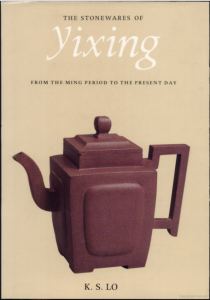 I love this book. It’s presented in an oversized coffee table-style layout, with plates of colour and grey-scale photos from museums. But it also contains a textbook level of information, going into detail about the evolution of manufacture and style of teapots through the years, listing major contributing potters to each era, and showing copious examples of each’s work.
I love this book. It’s presented in an oversized coffee table-style layout, with plates of colour and grey-scale photos from museums. But it also contains a textbook level of information, going into detail about the evolution of manufacture and style of teapots through the years, listing major contributing potters to each era, and showing copious examples of each’s work.
But here’s the story. I checked this out a little before COVID19 forced libraries to close, back in the end of January. It’s August as I finish typing this. Can’t say I’m complaining, and it’s given me time to take some seriously detailed notes. Libraries are finally opening up, and the book has a due date September 1st, roughly half a year later.
This book likely would have benefited from some charts and short-form information, but otherwise it’s highly detailed, laying out the history of yixing from its earliest popularization in the Ming (and going beyond that to early neolithic descriptions of zisha clay use), leading you through its evolution through the Ming into the Qing, how potteries shut down after the end of the Qing and then their eventual revival with the rise of the People’s Republic, leading us up to present day. Its main focus is on that history, laying out how the style of pots commissioned changed through each era, as well as the style of decoration, seals, signatures and calligraphy.
Lo also spends a lot of time delving into who was commissioning or making these pots at the time, and how that effected the style of pot produced. From early scholars and mandarins, to their disgrace and a switch to commercialization and export, and finally to the more standardized setup introduced by the People’s Republic. Through each era, Lo details the most prominent potters (as well as scholars commissioning pots, and calligraphers inscribing them), and short biographies on each, as well as examples of their work, if they exist.
There’s a lot to take away from this book, but here are some of my favourite hightlights: The pear-shaped teapot form, where it originated (Hui Mengchen of the Ming) and how it went on to influence and dominate Western teapots for years. The tables breaking down zisha chemistry, the different clay types, processing styles, and diagrams of dragon kilns.
This book is both a good standalone read (for the walk through history), as well as a textbook to keep for reference, both to quickly look up some potters’ styles and trends, and for the images. It’s not an all-encompassing guide to historic yixing potters, but definitely a solid reference anyhow.
Published in 1986 and since out of print, it’s not the most accessible book to get a hold of. I’ve found it for anywhere between $700-$1200.




24/08/2020 at 12:59 PM
It focuses only on Chinese teapots, doesn’t it?
Nothing on Japanese or European?
29/08/2020 at 10:02 AM
Yes. Only on Yixing teapots. But some on their export and influences on Europe and Japan.